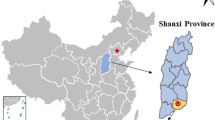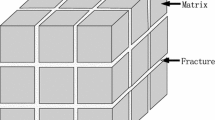Abstract
Middle-rank coal reservoirs in the Chinese coalbed methane (CBM) industry are receiving increasing interest due to their highly developed seepage pore, rendering the classic dual porosity/single permeability model insufficient for CBM well predictions and analysis. This research employed low-field nuclear magnetic resonance to examine the pore system of coal reservoirs and assess the impacts of 11 reservoir parameter variations on CBM well performance using a triple porosity/dual permeability model. Results indicated that the seepage pore constituted approximately 57% of the total pore volume, surpassing the adsorption pore (38%) and cleat (5%). Comparing simulation results for a well in the western Guizhou CBM basin revealed that the dual porosity/single permeability model yielded more gas than the triple porosity/dual permeability model, while the opposite held true for water production, implying that dual porosity/single permeability model is not suitable when seepage pore is developed. Sensitivity analysis based on the triple porosity/dual permeability model demonstrated that thicker coal seams significantly increase recoverable CBM resources, coal thickness exerted the most significant influence on CBM production, followed by seepage pore water saturation and cleat permeability/porosity. Factors such as critical desorption pressure, hydraulic fracture permeability, fracture half-length, Langmuir volume, and seepage pore permeability had comparatively less significant impacts. This study underscores the importance of accounting for seepage pore when developing middle-rank coal reservoirs for CBM production and can offer valuable insights for future CBM development in the study area.





















Similar content being viewed by others
Notes
1 mD = 1 millidarcy = 9.869233-16 m2
1 psi = 0.0068947573 MPa
References
Arusoaie, A., & Chiriţă, S. (2022). Waves in the theory of elasticity for triple porosity materials. Meccanica, 57(3), 641–657.
Brooks, R. H. (1965). Hydraulic properties of porous media. Colorado State University.
Chen, S., Tao, S., Tang, D., Xu, H., Li, S., Zhao, J., Jiang, Q., & Yang, H. (2017). Pore structure characterization of different rank coals using N2 and CO2 adsorption and its effect on CH4 adsorption capacity: A case in panguan syncline, Western Guizhou, China. Energy & Fuels, 31(6), 6034–6044.
Connell, L. D., Lu, M., & Pan, Z. (2010). An analytical coal permeability model for tri-axial strain and stress conditions. International Journal of Coal Geology, 84(2), 103–114.
Fan, C., Elsworth, D., Li, S., Chen, Z., Luo, M., Song, Y., & Zhang, H. (2019). Modelling and optimization of enhanced coalbed methane recovery using CO2/N2 mixtures. Fuel, 253, 1114–1129.
Fick, A. (1855). Ueber diffusion. Annalen der Physik, 170(1), 59–86.
Gao, Q., Liu, J., Huang, Y., Li, W., Shi, R., Leong, Y., & Elsworth, D. (2022). A critical review of coal permeability models. Fuel, 326, 125124.
Hu, H., & Chen, J. (2019). Determination and application of critical desorption pressure in overpressure seam of Western Guizhou. Coal Science and Technology, 47(01), 220–225.
Langmuir, I. (1916). The constitution and fundamental properties of solids and liquids. Part I. Solids. Journal of the American Chemical Society, 38(11), 2221–2295.
Li, X., Fu, X., Ranjith, P. G., & Xu, J. (2019). Stress sensitivity of medium- and high volatile bituminous coal: An experimental study based on nuclear magnetic resonance and permeability-porosity tests. Journal of Petroleum Science and Engineering, 172, 889–910.
Li, C., Yang, Z., Chen, J., & Sun, H. (2022). Prediction of critical desorption pressure of coalbed methane in multi-coal seams reservoir of medium and high coal rank: A case study of Eastern Yunnan and Western Guizhou, China. Natural Resources Research, 31(3), 1443–1461.
Liu, Z., Liu, D., Cai, Y., Yao, Y., Pan, Z., & Zhou, Y. (2020). Application of nuclear magnetic resonance (NMR) in coalbed methane and shale reservoirs: A review. International Journal of Coal Geology, 218, 103261.
Moore, T. A. (2012). Coalbed methane: A review. International Journal of Coal Geology, 101, 36–81.
Pan, Z., & Connell, L. D. (2012). Modelling permeability for coal reservoirs: A review of analytical models and testing data. International Journal of Coal Geology, 92, 1–44.
Pan, Z., & Connell, L. D. (2015). Reservoir simulation of free and adsorbed gas production from shale. Journal of Natural Gas Science and Engineering, 22, 359–370.
Quan, F., Wei, C., Hao, S., Ma, J., Song, Y., & Lian, D. (2022). Interference analysis of methane co-production from two coal seams in Southern Qinshui Basin. Natural Resources Research, 31(3), 1475–1502.
Quan, F., Wei, C., Li, R., Hao, S., Zhang, J., Song, Y., & Yan, G. (2023). Reservoir damage in coalbed methane commingled drainage wells and its fatal impact on well recovery. Natural Resources Research, 32(1), 295–319.
Reeves, S., & Pekot, L. (2001). Advanced reservoir modeling in desorption-controlled reservoirs. SPE Rocky Mountain Petroleum Technology Conference. OnePetro.
Seidle, J. P., Jeansonne, M. W., & Erickson, D. J. (1992). Application of matchstick geometry to stress dependent permeability in coals. SPE Rocky Mountain Regional Meeting. OnePetro.
Shen, J., Zhao, J., Qin, Y., Shen, Y., & Wang, G. (2018). Water imbibition and drainage of high rank coals in Qinshui Basin, China. Fuel, 211, 48–59.
Song, Y., Jiang, B., Wei, C., Dai, X., Quan, F., Hou, C., & Cheng, G. (2021). A review on the application of molecular dynamics to the study in coalbed methane geology. Frontiers in Earth Science, 9, 1134.
Song, Y., Jiang, B., Vandeginste, V., & Mathews, J. P. (2022). Deformation-related coalification: Significance for deformation within shallow crust. International Journal of Coal Geology, 256, 103999.
Sonier, F., Souillard, P., & Blaskovich, F. T. (1988). Numerical simulation of naturally fractured reservoirs. SPE Reservoir Engineering, 3(04), 1114–1122.
Thararoop, P., Karpyn, Z. T., & Ertekin, T. (2012). Development of a multi-mechanistic, dual-porosity, dual-permeability, numerical flow model for coalbed methane reservoirs. Journal of Natural Gas Science and Engineering, 8, 121–131.
Tian, J., Wang, L., Zhao, R. R., Liu, H. Q., Zhang, H., & Sima, L. Q. (2022). Improved triple porosity model for calculating porosity exponent of fractured-vuggy reservoirs based on Maxwell-Garnett mixing rule and anisotropic conductivity analysis. Journal of Petroleum Science and Engineering, 212, 110265.
Wang, H., Cheng, X., Tian, J., Li, T., Wang, W., Pan, J., Niu, Q., Feng, S., Hao, H., & Zhang, Y. (2020). Permeability enhancement of low rank coal through acidization using H2S solution: An experimental study in the Kuqa-Bay Coalfield, Xinjiang, China. Journal of Petroleum Science and Engineering, 185, 106476.
Wang, G., Xu, F., Xiao, Z., Zhang, L., Jiang, Y., Jiang, F., & Zheng, C. (2022). Improved permeability model of the binary gas interaction within a two-phase flow and its application in CO2-enhanced coalbed methane recovery. ACS Omega, 7(35), 31167–31182.
Wei, M., Liu, J., Elsworth, D., & Wang, E. (2018). Triple-porosity modelling for the simulation of multiscale flow mechanisms in shale reservoirs. Geofluids, 2018, 1–11.
Wei, Z., & Zhang, D. (2010). Coupled fluid-flow and geomechanics for triple-porosity/dual-permeability modeling of coalbed methane recovery. International Journal of Rock Mechanics and Mining Sciences, 47(8), 1242–1253.
Xu, H., Qin, Y., Wu, F., Zhang, F., Liu, W., Liu, J., & Guo, M. (2022). Numerical modeling of gas extraction from coal seam combined with a dual-porosity model: Finite difference solution and multi-factor analysis. Fuel, 313, 122687.
Yang, Z., Qin, Z., Wang, G., & Li, C. (2021). Environmental effects of water product from coalbed methane wells: A case study of the Songhe well group, Western Guizhou, China. Natural Resources Research, 2021(30), 3747–3760.
Yao, Y., Liu, D., Che, Y., Tang, S., Tang, D., & Huang, W. (2010). Petrophysical characterization of coals by low-field nuclear magnetic resonance (NMR). Fuel, 89(7), 1371–1380.
Yu, S., Fangkai, Q., & Junhong, Y. (2022). Diffusion of guest molecules in coal: Insights from simulation. Fuel, 323, 124295.
Zhang, Z., Qin, Y., Bai, J., Li, G., Zhuang, X., & Wang, X. (2018). Hydrogeochemistry characteristics of produced waters from CBM wells in Southern Qinshui Basin and implications for CBM commingled development. Journal of Natural Gas Science and Engineering, 56, 428–443.
Zhang, J., Wei, C., Vandeginste, V., Ju, W., Qin, Z., Quan, F., & Soh Tamehe, L. (2019a). Experimental simulation study on water migration and methane depressurizing desorption based on nuclear magnetic resonance technology: A case study of middle-rank coals from the panguan syncline in the Western Guizhou Region. Energy & Fuels, 33(9), 7993–8006.
Zhang, J., Wei, C., Ju, W., Yan, G., Lu, G., Hou, X., & Kai, Z. (2019b). Stress sensitivity characterization and heterogeneous variation of the pore-fracture system in middle-high rank coals reservoir based on NMR experiments. Fuel, 238, 331–344.
Zhang, J., Wei, C., Ju, W., Qin, Z., Ji, Y., Quan, F., & Hu, Y. (2020). Microscopic distribution and dynamic variation of water under stress in middle and high rank coal samples. Journal of Natural Gas Science and Engineering, 79, 103369.
Zhang, Z., Qin, Y., You, Z., & Yang, Z. (2021). Distribution characteristics of in situ stress field and vertical development unit division of CBM in Western Guizhou, China. Natural Resources Research, 30(5), 3659–3671.
Zhang, J., Chu, X., Wei, C., Zhang, P., Zou, M., Wang, B., Quan, F., & Ju, W. (2022a). Review on the application of low-field nuclear magnetic resonance technology in coalbed methane production simulation. ACS Omega, 7(30), 26298–26307.
Zhang, S., Tang, S., Meng, S., Xin, D., Zhang, Y., & Wang, X. (2022b). Water-bearing characteristics of coal reservoirs and its control mechanism on coalbed methane production. Journal of China Coal Society. https://doi.org/10.13225/j.cnki.jccs.2022.0122
Zheng, S., Yao, Y., Liu, D., Cai, Y., & Liu, Y. (2019). Nuclear magnetic resonance surface relaxivity of coals. International Journal of Coal Geology, 205, 1–13.
Zou, M., Wei, C., Zhang, M., Shen, J., Chen, Y., & Qi, Y. (2013). Classifying coal pores and estimating reservoir parameters by nuclear magnetic resonance and mercury intrusion porosimetry. Energy & Fuels, 27(7), 3699–3708.
Zou, M., Wei, C., Yu, H., & Song, L. (2015a). Modeling and application of coalbed methane recovery performance based on a triple porosity/dual permeability model. Journal of Natural Gas Science and Engineering, 22, 679–688.
Zou, M., Wei, C., Huang, Z., & Wei, S. (2015b). Porosity type analysis and permeability model for micro-trans-pores, meso-macro-pores and cleats of coal samples. Journal of Natural Gas Science and Engineering, 27, 776–784.
Zou, M., Wei, S., Huang, Z., Lv, X., & Guo, B. (2018). Simulations on recoverability performances for a coalbed methane field in SE edge of Ordos basin, China. Fuel, 233, 354–360.
Acknowledgments
This research was sponsored by the National Natural Science Foundation of China (No. 42102210), Major Science and Technology Projects of Xinjiang Uygur Autonomous Region (2022A03015-3), the Tianshan Talent Training Program of Xinjiang Uygur Autonomous Region (2022TSYCLJ0021) and Key Laboratory of Coalbed Methane Resources and Reservoir Formation Process of the Ministry of Education (China University of Mining and Technology) (No. 2020-009).
Author information
Authors and Affiliations
Corresponding authors
Ethics declarations
Conflict of Interest
The authors declare no competing financial interests or personal relationships that could have appeared to influence the work reported in this paper.
Rights and permissions
Springer Nature or its licensor (e.g. a society or other partner) holds exclusive rights to this article under a publishing agreement with the author(s) or other rightsholder(s); author self-archiving of the accepted manuscript version of this article is solely governed by the terms of such publishing agreement and applicable law.
About this article
Cite this article
Wei, B., Quan, F., Song, Y. et al. Analysis of a Middle-Rank Coal Reservoir on a Triple Porosity/Dual Permeability Model. Nat Resour Res 32, 2197–2222 (2023). https://doi.org/10.1007/s11053-023-10232-1
Received:
Accepted:
Published:
Issue Date:
DOI: https://doi.org/10.1007/s11053-023-10232-1




